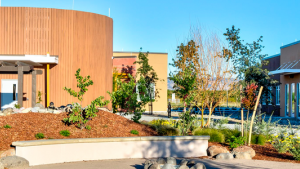Climate stressors and impacts
The Northeast continues to be confronted with extreme weather, most notably extreme precipitation—which has caused problematic flooding across the region, as documented in the Northeast Chapter of the Fifth National Climate Assessment. Additionally, sea level is rising at an increasing pace. As a result, some buildings near the coastline are vulnerable to flooding. This facility on the water in Boston planned ahead to withstand anticipated flooding.
A hospital designed for resilience
Seagate Rehabilitation & Nursing Center was built in 1994. Due to its proximity to the ocean, the center was designed to comply with building code requirements for flood-resistant construction.
The entire facility is elevated nearly 30 feet above ground, with parking spaces located below. All of the building’s systems and equipment are elevated, protecting them from floodwaters. The emergency power supply has sufficient capacity to run medical equipment, elevators, and heating, ventilation, and air conditioning (HVAC) systems without outside power, ensuring that the facility can continue to operate during power outages. Moreover, the elevated first floor contains only the lobby and other support services. Community and administrative space is located on the second floor, and residents’ and patients’ rooms start on the third.
Trial by water
During Hurricane Sandy, as the storm surge incapacitated buildings all along the New York and New Jersey coasts, Seagate functioned precisely as planned. At the peak of the storm, floodwaters filled the parking area and reached the lobby door, but did not enter the building.
Emergency power generators remained safe and supplied backup power for four days despite an area-wide power outage. The nursing home’s emergency plans for food and medical supplies enabled staff and patients to shelter in place despite limited transportation for incoming supplies. Seagate not only provided continuous care to its residents during and after Sandy, it also assisted local community members seeking food and shelter.

